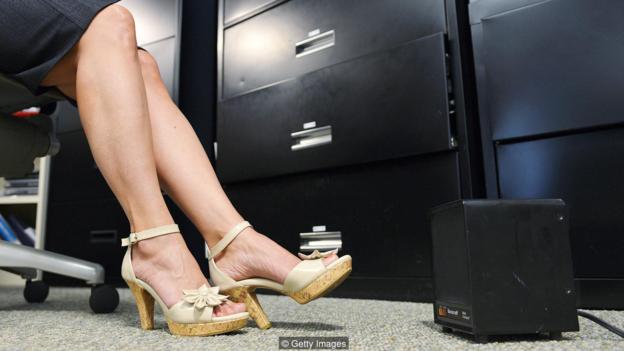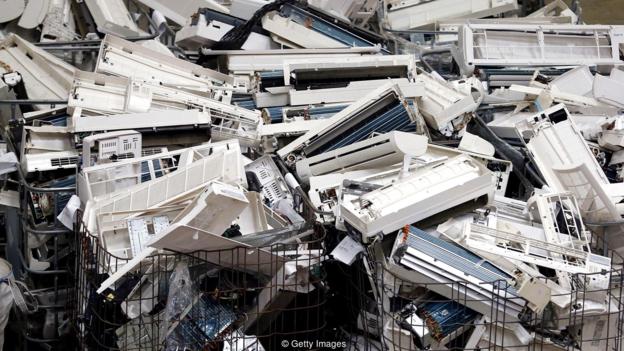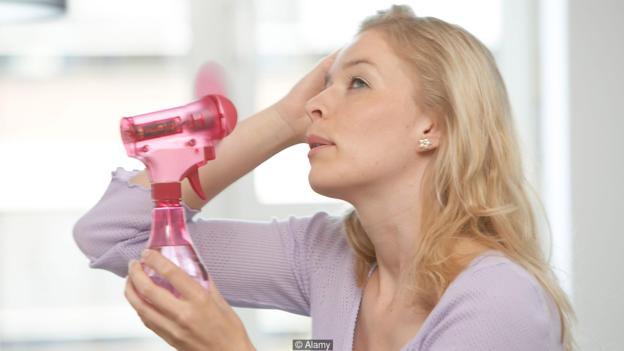Does a cold office make you more productive?


Young woman with scarf beret and glove shivering
For thousands of years, achieving a comfortable room temperature in hot climates was a constant struggle. People tried all sorts of tricks, from hanging wet mats outside their windows to having slaves fan air over a pile of snow through a hole in the ceiling.
I had a colleague who’d get so hot, sometimes he’d run into a restroom cubicle and take off all his clothes. He’d just stand there, trying to cool down
Fast-forward to 2016 and a refreshing glacial breeze can be yours at the flick of a thermostat.
And yet, the majority of workers still aren’t content. A 2015 survey of 129 office workers in the US found that 42% of people think their building is too warm, while 56% think it’s too cold. Now that we can have our offices whatever temperature we like, we just can’t agree what temperature that is.
It’s a dilemma Ben Morse, a freelance office worker in London, knows only too well. “In my current office there’s a daily debate about the temperature. The air con is on and off three or four times a day.”
The air con is on and off three or four times a da
Ai Ling Chang, a project manager based in Singapore, has encountered some extraordinary strategies over the years. “In one office, my friend had a chair with arm rests, she would pad it all round with cushions to keep warm. In another I had a colleague who’d get so hot, sometimes he’d run into a restroom cubicle and take off all his clothes. He’d just stand there, trying to cool down.”

An illustration shows an office worker warming up her legs with a portable on heater June 5, 2012 in Washington, DC. AFP PHOTO/Mandel NGAN (Photo credit should read MANDEL NGAN/AFP/GettyImages)
Failing to keep workers comfortable isn’t simply mean – it has serious financial implications too. In all, around 2% of office hours in the UK are wasted by battles for climate control, costing the economy more than £13 billion each year. In Australia, stifling heat cools productivity to the tune of US$6.2 billion.
Getting the temperature right can boost job satisfaction, productivity and collaboration. Getting it wrong can make workers slow, fat, or even sick.
Finding an office temperature to please everyone, all the time is basically impossible
Facebook founder Mark Zuckerberg swears by the mind-focusing effects of a truly arctic conference room: the thermostat is set to 15°C (59F). Meanwhile President Obama keeps the Oval Office so hot, his adviser joked to the New York Times that “You could grow orchids in there”.
So who’s right – the colleague cowering under the hand-dryer, or the guy taking off his jacket?

A picture taken on February 27, 2013 shows parts of air-conditioning devices at the Company Induraees factory, specialized in electric and electronic waste recycling, in Osorno, northern Spain. AFP PHOTO / CESAR MANSO (Photo credit should read CESAR MANSO/AFP/Getty Images)
As it turns out, we’re asking the wrong question. Over the years, employers have spent millions on research, discovering what many of us knew all along: finding an office temperature to please everyone, all the time is basically impossible. “Part of the problem is trying to work out the ‘correct’ temperature. It depends what you’re measuring,” said David Shipworth, a researcher at the UCL Energy Institute.
Take productivity – something most employers have a vested interest in. One study looked at the impact of the ambient temperature on worker efficiency, by tracking the activity of clerks in an insurance office. Although it measured the activity of just nine women, the results were arresting. At 25°C (77F) they were typing non-stop with an error rate of just 10%. When the temperature dropped five degrees, they were half as productive, more than doubling the number of mistakes.
But it’s not quite that simple. When students were asked to pick the most cost-effective mobile phone plan from two options in either a cool (19°C or 66F) or a warm (25°C or 77F) room, the group in the cooler room chose the right plan twice as often, suggesting complex decisions are more difficult when we’re warm.
The ambient temperature can do more than influence your productivity – it can change the way you think
In fact, the ambient temperature can do more than influence your productivity – it can change the way you think. Warm environments are better for creative thinking, while cooler workplaces are thought to help keep people alert during repetitive or monotonous tasks. Above 27°C (80.6F) we’re not so good at mathematics.

BRBMJ5 Woman sweating in the office
Perhaps even more surprisingly, ambient temperature can have a direct impact on your ability to collaborate; a small study of 33 people showed those in warmer rooms are more likely to harbour warm feelings about those around them. Even holding a hot cup of coffee encourages workers to judge others as more generous and caring – while iced coffee leads to the cold shoulder.
A review of the evidence found the ideal temperature for ‘typical’ office work – calls to customers, processing text documents, etc. – is 22°C (71.6F). But before you go blaming your last performance review on a poorly adjusted thermostat, consider this: studies in the field are often small, involving fewer than 100 participants.
Yes, ladies, there’s a reason you’re freezing to death at work
Once you’ve decided what kind of mental agility you’re aiming for, next you need to decide who you want to please. Working on the principle that there will always be someone complaining, those in the field gauge thermal comfort by how many people will feel uncomfortable at any given temperature, the Predicted Percentage of Dissatisfied (PPD).
The metabolic rate which currently controls the office thermostat is based on a 40-year-old, 70kg man
To calculate the PPD, most building managers use a standard 1960s formula, which takes into account factors such as the clothing and metabolic rate (how fast we generate heat) of a building’s inhabitants. Tellingly, the latter requires a number of assumptions about their age, weight and – crucially – gender.
The metabolic rate which currently controls the office thermostat is based on a 40-year-old, 70kg man. So Boris Kingma from Maastricht University Medical Center decided to take a closer look. He found that women have significantly lower metabolic rates than men and need their offices 3°C (37.4F) warmer.
The discrepancy is explained in large part by the fact that women have fewer muscle and more fat cells, which are less active and produce less heat.
The women in my office keep their coats on their chairs because they know they’ll have to put them on during the day
To many office workers, this will hardly come as a surprise. “The women in my office keep their coats on their chairs because they know they’ll have to put them on during the day. Someone had hand warmers in the microwave once,” Ben said.
If your boss still won’t ease off on the air conditioning, there are other ways to warm up. That’s because, according to the latest psychological experiments, our inner thermometers are nowhere near as reliable as we think.
For a small study published this year, each of the 32 participants spent an hour in a room illuminated with either a ‘warm’, sunset glow or ‘cool’ lighting and reported how warm they felt every ten minutes. What the volunteers didn’t know was that the room temperature was either being increased or decreased while they were there.
Despite this, volunteers on a cooling cycle felt significantly warmer under the ‘warm’ light than those under the ‘cool’ light. “There’s a long historical association there, potentially dating back to red campfires and blue ice,” said UCL researcher Shipworth.
The hope is that one day psychological tricks could keep workers happy while saving on energy bills.
Steering clear of the thermostat may have other benefits. In Kingma’s view, spending most of our lives in temperature-controlled environments isn’t just environmentally irresponsible, it could be harming our health – contributing to the obesity epidemic and fuelling the rise of metabolic disorders such as diabetes.
“By exposing yourself to mild cold and mild warm environments you get both cardiovascular and metabolic exercise,” he said.
Mild temperature variation may be healthy – but working in extreme heat or cold can be downright dangerous. So what are your rights? While there’s a legal minimum working temperature in most countries (16°C in the UK, 60.8F), many don’t set an upper limit, stating instead that the temperature should be ‘reasonable’.
Of course, this is rarely a problem in the UK. But when the sun does come out, many employers are ill-prepared. “Offices, hospital wards and classrooms – especially if they are situated in older buildings – can become unbearably hot.” Said Dave Prentis, general secretary of the trade union UNISON. “The UK has had a legal minimum temperature for years, a legal maximum is long overdue."
If you do find yourself working in a sauna, try ganging up with your colleagues
If you do find yourself working in a sauna, try ganging up with your colleagues; employers in the UK are legally required to assess the temperature if 10% of staff complain. In Australia, above 34°C (93.2F) workers are entitled to take 30 minutes off per hour. If all else fails, invoke your right to free drinking water, regular breaks – and ‘sufficient’ thermometers.
All said, the thermostat wars might be at an end. “We’re increasingly moving towards personalised control,” said Shipworth. That means desks with their own climate systems – heating units radiating warmth on to the tops of your legs, air vents you can open and close – like those in airplanes.
So what is the best office temperature? It’s impossible to say, but it’s likely to lie somewhere between 22 and 24°C (71.6 – 75.2F), according to Shipworth. Take it from Singapore’s first prime minister, Lee Kuan Yew, who passionately believed the optimal temperature was exactly 22°C. When asked in 1999 what was responsible for the tropical country’s economic success, he gave an unexpected reply: air conditioning.
Политика конфиденциальности | Правила пользования сайтом







